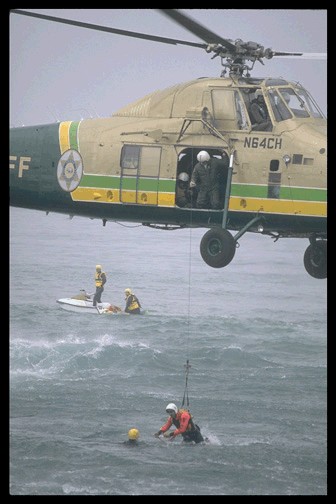|
  Air to air communication is critical for safe aircraft operations. And, because
of standards in training, equipment and frequency allocation, air to air
communication is generally reliable. Air-to-ground communication, on the other
hand, is not quite as reliable and can lead to serious problems during normal
aircraft operations.
Air to air communication is critical for safe aircraft operations. And, because
of standards in training, equipment and frequency allocation, air to air
communication is generally reliable. Air-to-ground communication, on the other
hand, is not quite as reliable and can lead to serious problems during normal
aircraft operations.
There are over 17,000 state and local
law enforcement agencies in the United States. For very practical reasons, each
police agency has its own radio frequency or frequencies. Moreover, each state and
local agency is influenced by a political parent organization, such as a
municipal police force, and is ultimately managed by a city. When making
budgetary choices, organizations spend money for public safety-related
technologies at vastly different rates.
The combination of local choices and
the need to have independent police radio frequencies has created technological
fragmentation in public safety. Efforts to solve fragmentation are often
focused on increasing interagency interoperability. Aviation is particularly
susceptible to interoperability issues. For instance, a vehicle pursuit may
cross jurisdictional lines, and aircrews may be forced to communicate with
different agencies. One jurisdiction (like a state or country) may have aviation
assets that a smaller agency within the larger jurisdiction may not.
A first step in understanding how and
why communication systems may not be compatible is a brief explanation of the
concept of frequency allocation. Recall that there are thousands of state and
local law enforcement agencies who need radio frequencies. In addition to
the myriad of law enforcement agencies using radio frequency communications, there are
commercial, military and amateur users as well, to name a few. Furthermore,
practical radio frequencies are a finite resource. There are only so many
frequencies that can be used for police radio communications.
Further complicating the
competition between users of the finite resource is the fact that radio
frequencies have characteristics that define their usefulness. This means that
when decisions about allocation are made, there are trades-offs. For instance,
lower frequencies tend to go farther than higher frequencies. This means that
higher frequency "channels" can be re-used by geographically distant agencies
more often than lower frequencies. Think of driving across country you leave
home listening to your favorite radio station. Soon, your station fades, is
replaced by static, ultimately disappears and then is slowly replaced by another
radio station. Effectively, the frequency of your original station can be reused
because it is distant enough from another broadcaster.
Many public safety organizations,
like police departments, find
themselves allocated to 800MHz (a relatively high frequency). This means they
probably have more repeater antennas to obtain coverage over a large area. In
addition to using 800MHz, newer radio frequency configurations use digital technology.
Driving across country, your commercial radio station was likely broadcasting an
analog signal. A primary difference between analog and digital signals is how
the signals reception reacts on distance. As you drove away from your
commercial station, you heard increasing static and interference, but you could
continue to understand the broadcast.
On the other hand, the usefulness of
digital radio frequency communications tends to suddenly drop off, not fade away. Think of it
this way; with the fading commercial station, you are able to listen intently,
filter the static and interference and probably infer some of what you miss
you know the lyrics to the song, so if a few words are garbled you continue
singing along. With digital communications, voices and sounds are converted into
the same binary code that computers use. At the point where interference causes
enough of the ones and zeros to drop, the signal cannot be converted back into
words. So, whereas analog signals tend to gradually decrease in usability,
digital signals tend to cease all at once.
The characteristics of 800MHZ digital
radio are not all negative. Indeed, many of them are quite beneficial. For
instance, the distance factor has meant that more frequencies are open to use by
public safety. Also, high frequency transmissions can have better building
penetration than lower frequencies. However, the addition of more frequencies to
law enforcement, and particularly aviation, is not necessarily a benefit. Having
to keep track of scores of frequencies can be unsafe and counterproductive. In
the past, if aviation assets arrived over the scene of an incident after the
ground units, at least one of the ground units would have to switch to a
frequency that the aircraft maintained. However, switching frequencies in the
middle of a tactical operation or emergency is something that should be avoided.
When an 800 MHZ digital radio
frequency scheme is
combined with a trunked radio system, both air and ground units are provided
potential answers to communication problems. Even with the increased use of high
frequencies, there are still only so many to be used. Lets presume that a
mid-sized municipal government is provided with 10 frequencies. In the past,
they would have to divide these 10 between police, fire and other government
services. If they provided police and fire with one uplink and one downlink each
and one tactical each, they would have used 60 percent of their frequency
allocation. However, anyone who has worked graveyard shifts knows that the air
can be dead for long periods of time. Indeed, even during peak times there is a
lot of dead space between transmissions.
A trunked radio system takes
advantage of this space between transmissions by using Frequency Division
Multiple Access (FDMA). As an analogy, lets compare railroad and highway
transportation. When frequencies are assigned for a specific group of users, it
is like a railroad. A municipal agency with 10 frequencies has 10 tracks and
only one train, or group of users, can be on a track. FDMA is much more like a
highway, wherein each group of users is a like a bus and each frequency is a
lane. The users who want to communicate with each other are on the same bus. As
the bus drives down the highway, it can change to an open lane. The users are
grouped together on the same bus and referred to as a talk group.
As the name implies, the frequencies
are divided so that multiple users can access them. Although a medium size city
might only have ten frequencies, if it is using FDMA technology, it can have
many more "talk groups" that share the frequencies simultaneously. The reference
to a "trunked system" goes back to the beginning days of telephone when an
operator physically plugged cables into a panel in order to connect users. Now,
a computer constantly tracks the communications of the various talk groups and
the open frequencies. When one member of a talk group broadcasts (base, ground
or air), the computer selects an open frequency and shifts all users to that
frequency. This means that the computer is constantly in contact with all system
users, coordinating frequency use.
The State of Delaware has
approximately 1,982 square miles with about 850,000 residents. In addition to
the state police, who provide primary, full-service policing, there are 29 local
police agencies within the three counties that comprise Delaware. The
state police provide aviation law enforcement, fire support and medical services
to the entire state, and in some instances, surrounding states such as
Pennsylvania and Maryland. During the mid 1990s, Delaware undertook a state-wide
deployment of an 800MHZ trunked radio system. Eventually, the system would
encompass all government services including the different police agencies,
volunteer fire departments, hospitals and other emergency services.
For Delaware, the first task of the
project was to develop the talk groups. Because it is a statewide, coordinated
system, Delaware was able to designate different police, volunteer fire,
hospital and other public entities as specific talk groups. Now, aircrews are
provided a template which lists each of the different talk groups. Responding to
public safety emergencies throughout the state, Delaware aircrews are able to
punch in the number of the appropriate talk group and establish immediate
communications. In addition, aircrews often respond to emergencies within one of
the surrounding states. Some of those states have provided their FDMA talk
groups to Delaware, and the aircraft radios are pre-programmed. Other states
have decided (for technical reasons) to rely on radio communications patches via
their central dispatch centers. However, pre-programmed talk groups can be a
more reliable, quick way of establishing communications.
Because the trunked system relies on
repeating antennas, an aircraft that might normally be out of transmission range
can now easily communicate with ground units because the signal for the talk
group is passed along the system. In those instances when the aircraft is
responding from a distant location, instant and reliable communications can be
easily established.
With a trunked radio system,
communication can be improved between all public safety entities and aircrews.
Moreover, in large communications projects like the one in Delaware (and in
other states such as Colorado), although agencies share the same infrastructure,
each is able to communicate privately with its own personnel and with each other
during emergencies. Through the use of technology, limited RF resources
can not only be multiplied by intra and interagency communications, they can be
greatly enhanced.
|
